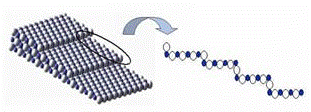Chemistry, Department of: Faculty Series

Marjorie A. Langell Publications
Document Type
Article
Date of this Version
May 1996
Abstract
Single crystal MnO(100) substrates can be selectively oxidized to produce Mn2O3- and Mn3O4-like surfaces under mild oxidation/reduction conditions readily accessed under ultrahigh vacuum (UHV). MnO(100) yields a characteristic Mn 2p x-ray photoelectron spectroscopy (XPS) satellite structure and appropriate O/Mn concentrations from O 1s/Mn 2p XPS intensity ratios. Its high resolution electron energy loss (HREEL) spectrum shows a series of Fuchs–Kliewer multiple phonon excitations with a single loss energy of 70.9 meV, characteristic of the cubic manganese monoxide structure. However, the HREEL spectral (HREELS) background is high and the phonons are not as well resolved as those typically observed on comparable metal monoxides. Annealing the MnO(100) substrate at 625 K and 5×10-7 Torr O2 slowly forms Mn2O3, as indicated by O 1s and Mn 2p XPS, and does so without significantly altering the symmetry of the MnO(100) low energy electron diffraction pattern. The MnO(100)-Mn2O3 surface can be selectively reduced to Mn3O4-like composition by heating under UHV to 775 K and to MnO(100) at 1000 K. HREEL spectra for the UHV annealed surfaces are well-resolved, and for the MnO(100)-Mn3O4 substrate a second fundamental phonon loss is observed at 55.6 meV as a result of the lower symmetry of the Mn3O4 spinel structure. The UHV-annealed MnO(100) surface appears to be more highly ordered since its HREELS phonon loss peaks are better resolved. It is also somewhat reduced, however, resulting in a less intense phonon spectrum with a fundamental loss energy of only 65.1 meV.


Comments
Published by American Vacuum Society. J. Vac. Sci. Technol. A 14(3), May/Jun 1996. ©1996 American Vacuum Society. Permission to use.